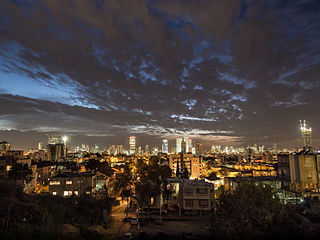
Givatayim is a city in Israel east of Tel Aviv. It is part of the metropolitan area known as Gush Dan. Givatayim was established in 1922 by pioneers of the Second Aliyah. In 2019 it had a population of 60,644.

Tel Aviv Sourasky Medical Center is the main hospital complex serving Tel Aviv, Israel and its metropolitan area and the second-largest hospital complex in the country. The complex is spread out over an area of 150,000 m2 and incorporates four hospitals: Ichilov General Hospital and Ida Sourasky Rehabilitation Center, Lis Maternity Hospital, and Dana Children's Hospital. The director of the Tel Aviv Sourasky Medical Center until September 2016 was Prof. Gabriel Barbash. He was replaced by Prof. Ronni Gamzu.

Chaim Sheba Medical Center at Tel HaShomer, also Tel HaShomer Hospital, is the largest hospital in Israel, located in the Tel Aviv District city of Ramat Gan at Tel HaShomer neighborhood, Israel. In 2020, Newsweek ranked it as the 9th-best hospital in the world. In 2021, it was ranked as the 10th best hospital in the world, scoring the highest for an Israeli hospital.

Dankal is a planned mass transit system for the Tel Aviv metropolitan area in central Israel. The system will include different modes of mass transit, including rapid transit (metro), light rail transit (LRT), and bus rapid transit (BRT). Overseen by the government agency NTA, the project will complement the intercity and suburban rail network operated by Israel Railways.

Hohlgangsanlage 8 was a partially completed underground hospital complex in St. Lawrence, Jersey, built by German occupying forces during the occupation of Jersey during World War II. Over 1 km (1,100 yd) of tunnels were completed. After the liberation of the Channel Islands, the complex was converted into a museum detailing the occupation and remains a visitor attraction.
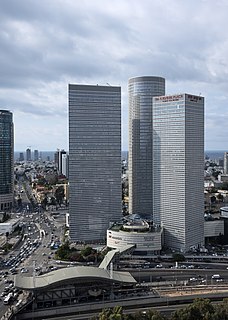
Azrieli Center is a complex of skyscrapers in Tel Aviv. At the base of the center lies a large shopping mall. The center was originally designed by Israeli-American architect Eli Attia, and after he fell out with the developer of the center David Azrieli, completion of the design was passed on to the Tel Aviv firm of Moore Yaski Sivan Architects.
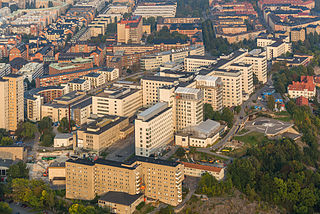
Södersjukhuset (Sös) is one of the largest hospitals in Stockholm, Sweden. Constructed between 1937 and 1944, it was designed by architects Hjalmar Cederström and Hermann Imhäuser, and the construction was contracted to Toll Byggnads AB. Södersjukhuset has the largest emergency department in Scandinavia.

The Shaare Zedek Medical Center is a major hospital in Jerusalem established in 1902.

Sammy Ofer was an Israeli shipping magnate and one of the richest men in the country.

Galilee Medical Center, abbreviated GMC, is a hospital located in the coastal city of Nahariya and is the second largest hospital in northern Israel. It was established in 1956.
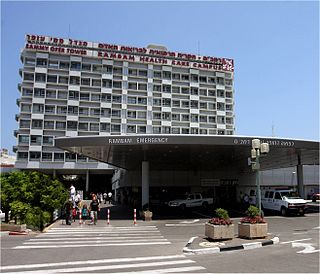
Rambam Health Care Campus commonly called Rambam Hospital, is a hospital in the Bat Galim neighborhood of Haifa, Israel founded in 1938, 10 years before the establishment of the State of Israel.

Arieh Sharon was an Israeli architect and winner of the Israel Prize for Architecture in 1962. Sharon was a critical contributor to the early architecture in Israel and the leader of the first master plan of the young state, reporting to then Prime Minister, David Ben-Gurion. Sharon studied at the Bauhaus in Dessau under Walter Gropius and Hannes Meyer and on his return to Israel in 1931, started building in the International Style, better known locally as the Bauhaus style of Tel Aviv. Sharon built private houses, cinemas and in 1937 his first hospital, a field in which he specialized in his later career, planning and constructing many of the country's largest medical centers.

Meir Medical Center is a hospital in Kfar Saba, Israel. It is the seventh largest hospital complex in the country, and is part of a network of hospitals owned and operated by Clalit Health Services.

Wolfson Medical Center is a hospital in the Tel Aviv District city of Holon, Israel. Wolfson Hospital is located in southern Tel Aviv Metropolitan Area in a vicinity abounded by a population of nearly half a million inhabitants. It ranks as the ninth largest hospital in Israel. The medical center was founded with the assistance of the Wolfson Foundation and named after Lady Edith Specterman Wolfson, Sir Isaac Wolfson's wife.

Assuta Medical Center is a private medical center in the Ramat HaHayal neighborhood in north Tel Aviv, Israel established in 1936. The hospital performs surgery and diagnostic procedures in all fields of medicine, including cardiology, oncology, gynecology and urology.
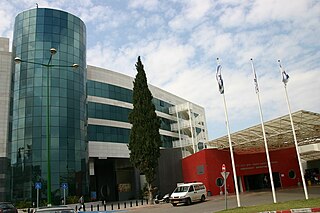
Shamir Medical Center, formerly Assaf Harofeh Medical Center, is a hospital located on 60 acres (24 ha), 15 kilometres (9.3 mi) southeast of Tel Aviv, Israel.
Jacob Gil is an Israeli architect and town planner
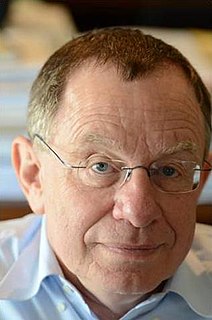
Rafael (Rafi) Beyar is an Israeli medical doctor, entrepreneur, and professor who is the eighth director of Rambam Health Care Campus since 1996. Beyar, an authority on interventional cardiology, also continues to practice in his specialty of clinical invasive cardiology. Beyar is the editor of several books related to cardiology and electrophysiology, including Frontiers in Interventional Cardiology, Proceedings from International Meetings, Analysis of Cardiac Development: from Embryo to Old Age; and co-founder of Corindus Vascular Robotics.

Schneider Children's Medical Center of Israel, founded in 1992, is a paediatric hospital focused on children's health, particularly organ transplantation and cancers. Schneider treats infants, children, teens, and young adults up to age 18 and for some conditions, age 21.

















